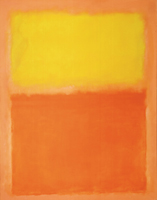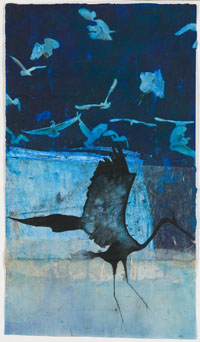| In This Issue |
 |
|
Welcome by Tom Singer
Introduction by Linda Carter and Ami Ronnberg
The Abstract Unconscious by Michael Evans
Permeability by Margot McLean and James Hillman
Read Other Issues of This Journal
Receive This Journal for Free
|
Welcome |
 |
|
 ARAS has had a remarkable year. Our Online Journal has begun to publish a series of stimulating papers from the San Francisco Art and Psyche Conference and is now being distributed free of charge to over 3,000 subscribers around the world. We are also excited that our new book, The Book of Images: Reflections on Symbols which has been in the making for a decade, will be published in 2010. Both of these efforts reflect the belief that our future should involve a more active extension into the broader world with the unique ARAS perspective on archetype, symbol, psyche and culture. ARAS has had a remarkable year. Our Online Journal has begun to publish a series of stimulating papers from the San Francisco Art and Psyche Conference and is now being distributed free of charge to over 3,000 subscribers around the world. We are also excited that our new book, The Book of Images: Reflections on Symbols which has been in the making for a decade, will be published in 2010. Both of these efforts reflect the belief that our future should involve a more active extension into the broader world with the unique ARAS perspective on archetype, symbol, psyche and culture.
We all know that such efforts take money. We hope that those of you who are able will make a generous contribution to the ongoing efforts of ARAS to further develop the archive itself, to make the Online Journal of greater value to a growing audience, and to support our research into archetypal symbolism and psyche. At the heart of our journal effort, I want to thank Ami Ronnberg, Linda Carter, Allison Langerak and Jeff Levinsky who form the core of the Online Journal team.
 |
Best wishes,
Tom Singer, M.D.
Co-Chair of ARAS Online for National ARAS
|
Introduction |
 |
|
 Readers should be thrilled to find two wonderful papers as holiday gifts in this new edition of the ARAS/Art and Psyche Online Journal. In "The Abstract Unconscious," Michael Evans, a British painter, tells of his painting method called "process painting" whereby he pours paint and waits with faith for an image to create itself out of interaction between the materials and the unconscious. Michael's paper is beautifully illustrated with examples of his work which are fascinating and rich with possibility and ambiguity. Margot McLean and James Hillman have offered us a spectacular collaborative presentation called "Permeability" that includes many of Margot’s bird paintings along with imaginative musings of prose and poetry woven together from their perspectives as artist and psychologist. This thoughtfully crafted piece will transport the reader through word and image into aspects of psyche that are both ethereal and earthy. We hope that you will enjoy these articles and that you will join us for our next edition in March which will focus on Jung's Red Book and mandalas. Readers should be thrilled to find two wonderful papers as holiday gifts in this new edition of the ARAS/Art and Psyche Online Journal. In "The Abstract Unconscious," Michael Evans, a British painter, tells of his painting method called "process painting" whereby he pours paint and waits with faith for an image to create itself out of interaction between the materials and the unconscious. Michael's paper is beautifully illustrated with examples of his work which are fascinating and rich with possibility and ambiguity. Margot McLean and James Hillman have offered us a spectacular collaborative presentation called "Permeability" that includes many of Margot’s bird paintings along with imaginative musings of prose and poetry woven together from their perspectives as artist and psychologist. This thoughtfully crafted piece will transport the reader through word and image into aspects of psyche that are both ethereal and earthy. We hope that you will enjoy these articles and that you will join us for our next edition in March which will focus on Jung's Red Book and mandalas.
From Linda Carter and Ami Ronnberg, Co-editors, ARAS/Art and Psyche Online Journal
|
Receive This Journal for Free |
 |
| If you're not already a subscriber and would like to receive subsequent issues of this journal by email at no cost, click here or e-mail us at journalfree@aras.org. |
|
 |
| The Abstract Unconscious |
 |
An excerpt from The Abstract Unconscious, by Michael Evans
|

Studio, 2004
Michael Evans
|
I would like to start with a brief introduction to my paintings, as they are the motivating force behind this text and the ideas contained within it. Perhaps I should start with one of the most basic aspects of my practice whereby my paintings are initiated through a detached method of pouring paint, I call it process painting; it provides a method to carry on painting in the face of doubt. Process, in one sense, requires no belief, just the material and the desire to make paintings. However, my desire is to make paintings that have "significance" and embody "meaning." For me, process takes on meaning as an act of faith in existence through a celebration of matter; though this may often be outside the conscious awareness of many artists. I am motivated by the pleasure of watching paint move around a surface waiting for a moment when the painting "makes itself" and meaning feels not to have come from me.
I view paint not only as capable of internal "expressive" possibilities but also as an external agent, existing "objectively" or externally, capable of containing expressive potential through the transformative act of the artist but also mysteriously capable of provoking aesthetic responses through its very substance and physical appearance, even without the "expressive" input of the painter. The process painter lets paint behave as paint. There ensues a careful watching of how materials behave and a sensitive response to these qualities. The writer James Elkins likened painting to alchemy, seeing painting as rooted in the physical but extending beyond it. He observes,
Science has closed off almost every unsystematic encounter with the world. Alchemy and painting are two of the last remaining paths into the deliriously beautiful world of unnamed substances. (Elkins 2000, p. 199)
Read the entire paper. |
Permeability |
 |
An excerpt from Permeability by Margot McLean and James Hillman

Untitled
Margot McLean |
Margot McLean: Permeability is a state of being porous so that images may alight and find a resting place, and set off elaborations. These happen not necessarily in the studio when concentrating on the work. They may even be impeded there. Similarly, elaborations of a dream into insights and recollections and interpretations do not necessarily happen in the analytic session but require a permeability throughout the day after the session and the days after the session, here, there, or anywhere, and not with the analyst but with anyone.
Artists work in an imagistic space. A space that has no beginning, no end, no middle. When is an artwork finished? When is a dream finished? The image seems to want to go on. Cézanne said a painting is complete at every stage of the work even if it is never finished.
James Hillman: I am concerned, beyond art-making, with the psychology of the incoming, which the San Francisco poet Robert Duncan called the invenio, Catholicism calls the Annunciation—the descent of logos into physical matter, the all-too-solid flesh. I am concerned less with what comes in than with the incurring, the fact of human permeability, the ordinary, quotidian and ubiquitous fact of visionary, ideational, auditory, symptomatic, and personified incursions.
Why can fantasy-thinking not be shut out?
The composer, the painter, the writer are not special human exceptions. They are the subtle more vulnerable examples—not of "weak ego", but of the essential nature of the human mind, that it is membranous, osmotic, susceptible, suggestible, seducible, seditious, hysterical.
Read the entire paper. |
Read Other Issues of This Journal |
 |
|
You'll find many interesting perspectives on archetypes, art, and psyche in earlier editions of this journal. Past issues include articles about specific archetypal themes, presentations from the 2008 Art and Psyche conference, interviews, and an entire free online book entitled Amplification of Symbols by former San Francisco ARAS curator Harry Prochaska. See all past issues.
|
|

